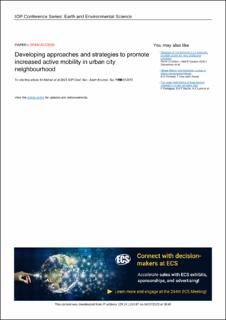| dc.description.abstract | With the world's population expanding quickly, cities must deal with problems such as traffic jams, air pollution, car accidents, and urban sprawl. Walking and cycling are non-motorized modes of transport that require little infrastructure and don't utilize any fossil fuel energy. In comparison to motorized modes, they are easily adaptable and inexpensive to maintain for both users and governments. Therefore, the goal of this paper is to identify strategies for greater active mobility through non-motorized modes of transport. Through a document study, methods that can be utilized as incentives to improve walkability and bikeability in the Elgeseter neighbourhood of the City of Trondheim, Norway have been identified. The analysis addresses following research question: “What may persuade Elgeseter district commuters or travellers to modify their behaviour toward more walking and biking?” This study reveals five topics of interest: Identifying existing difficulties in the district, Evaluation of current pedestrian, bicycle, and vehicle links, as well as meeting places and open spaces, and identification of opportunities to improve them, How to outline planning concepts, Methods and design recommendations for enhancing walking and micro transportation, as well as The importance of accessibility, safety, and comfort in attracting people to active mobility. The main argument is that a multi-dimensional approach is required to persuade more people to choose environmentally friendly, sustainable modes of transportation as a lifestyle choice, and function better than compulsion. The research presented in this paper contributes to our understanding of the factors that influence commuters' decision to engage in active mobility in their urban city neighbourhood. | en_US |

